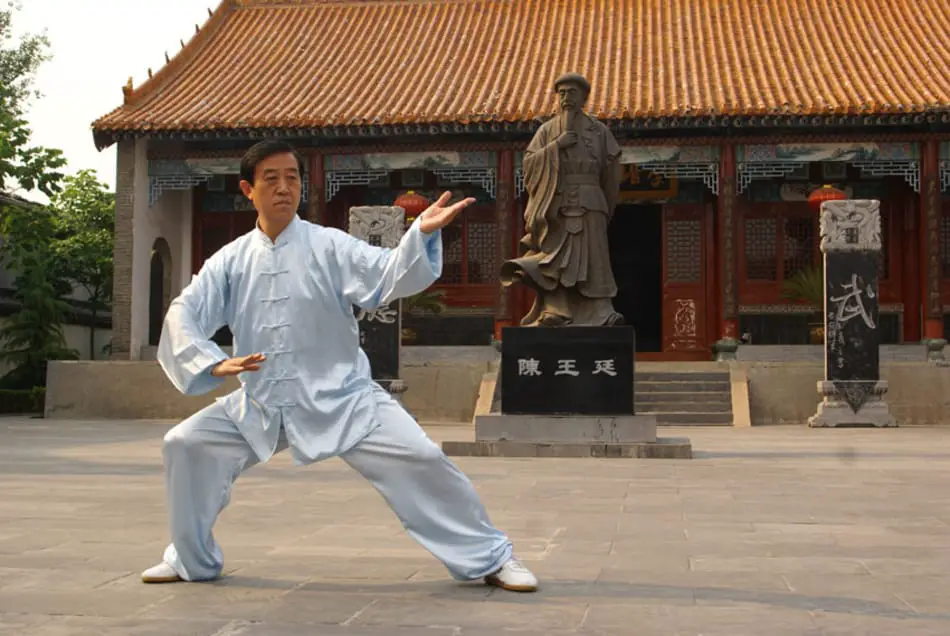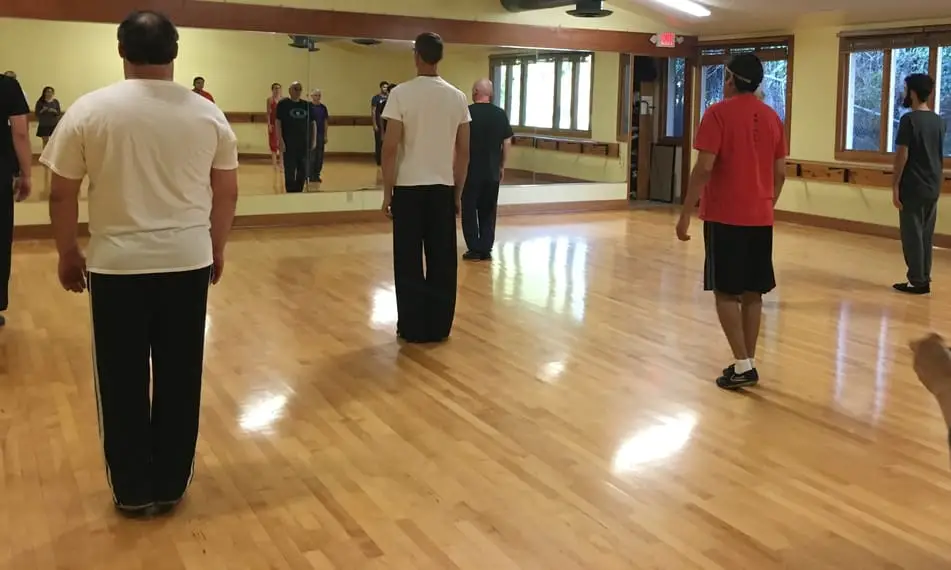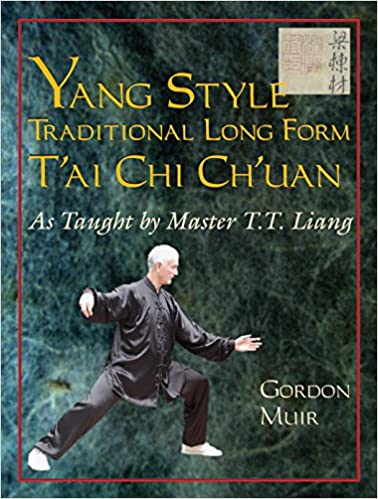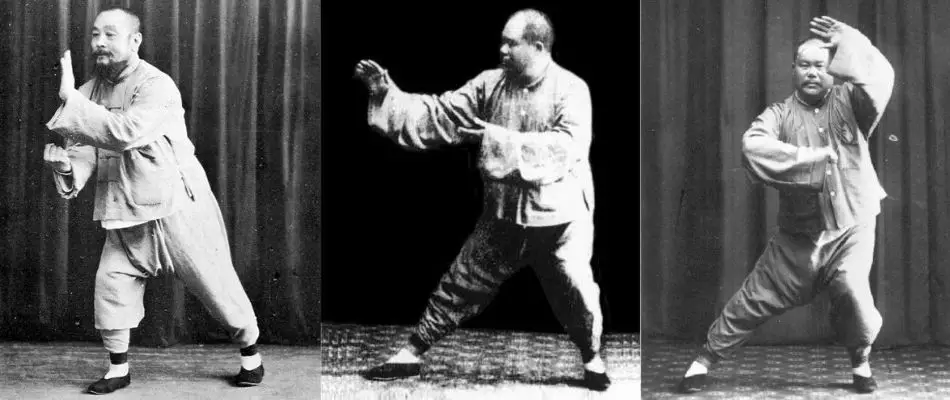In a workshop with Grand Master Chen Zhenglei he presented the Chen Tai Chi Long Form Old Frame in a way that caught the significance of the overall form by breaking it down into digestible sections. It was an eye-opening explanation of the purpose of each section and how they tie together.
Learning the tai chi long form takes a while but it is a worthy pursuit because the payoff is huge. The tai chi long form is the equivalent to a moving Bible. It is the culmination of thousands of years work by many contributors. Those who have this “bible” can focus on a myriad of topics such as health (qi, meridians, flexibility, agility), martial applications (strikes, kicks, locks), culture (history, language, movement names), or philosophy.
The tai chi long form is a series of movements that combine martial applications and soft, slow movements to improve health, increase strength, develop balance, and a create a calm mind. There are 56 -108 movements depending on style.
Teachers and students alike have the challenge of learning the entire sequence but the sections and explanations below create small successes and better understanding. Let’s talk about what the tai chi long form is, use the Chen form as an example to discuss the purpose of the different sections, and then show a Yang style tai chi form video and many other styles to highlight the different arts.

Breaking the Tai Chi Forms Into Teachable Segments
What is the most popular form of tai chi? The one your teacher teaches! the joke goes. The tai chi chuan yang style long form with 108 movements is by far the most practiced form. While all of us love the style we do, I will admit to being jealous of the number of resources and people to practice with across the globe.
For the purposes of this essay we are going to us the Chen Style Lao Jia (Old Frame) to talk through how tai chi forms can be broken into segments to be learned better. If you are a student, use this to give yourself permission to concentrate on sections and then glue them together. If you are a teacher, think about how to break the tai chi forms into segments to help your students’ progress.
The Old Frame contains most of the same-named movements of all the other styles so the explanations should be easy to understand and adapt to your own style. I also received direct instruction from Chen Zhenglei on this form so I was able to ask him about the purpose of the form sections. He is a very methodical tai chi teacher, presenting content in an organized manner much like a professor.
CHEN FAMILY TAIJIQUAN Old Frame First Path — Lao Jia Yi Lu — 老架一路
All of the truly verifiable history of tai chi date back to Chen Village in the 1700s and the first records of the Old Frame First Road (Lao Jia Yi Lu).
Tai Chi Long Form First Section
The tai chi form part 1 is made up of 15 movements set out in a very clear path. There is a clear transition between empty and full legs and you settle into each posture and pause before moving on.
1. Preparation Form — Tai Ji Chu Shi — 太極初勢
2. Vajra Pounds Mortar — Jin Gang Dao Dui — 金刚捣碓
3. Grasp and Tuck Clothes — Lan Zha Yi — 懒扎衣
4. Six Sealing, Four Closing — Liu Feng Si Bi — 六封四闭
5. Dan Tian Change — Dan Bian — 单鞭
6. Vajra Pounds Mortar — Jin Gang Dao Dui — 金刚捣碓
7. White Goose Spreads Wings — Bai E Liang Chi — 白鵝亮翅
8. Oblique Posture — Xie Xing — 斜行
9. Embrace Knee — Lou Xi — 搂膝
10. Twist Steps — Ao Bu — 拗步
11. Oblique Posture — Xie Xing — 斜行
12. Embrace Knee — Lou Xi — 搂膝
13. Twist Steps — Ao Bu — 拗步
14. Hidden Hand Punch — Yan Shou Gong Quan — 掩手肱拳
15. Vajra Pounds Mortar — Jin Gang Dao Dui — 金刚捣碓
Tai Chi Long Form Second Section
The tai chi long form part 2 has 13 movements. Six of these movements were in the first section. We enjoy familiar processes so the second portion compliments you for learning the key movements and adds seven more.
16. Brushing Body Fist — Pi Shen Quan — 撇身拳
17. Green Dragon Emerges From the Water — Qing Long Chu Shui — 青龍出水
18. TwoHanded Push — Shuang Tui Shou — 双推手
19. Palm Under Elbow — Zou Xia Kan Quan — 肘下看拳
20. Step Back and Push with Arm — Dao Juan Gong — 倒卷肱
21. White Goose Spreads Wings — Bai E Liang Chi — 白鵝亮翅
22. Oblique Posture — Xie Xing — 斜行
23. Flash the Back — Shan Tong Bei — 閃通背
24. Hidden Hand Punch — Yan Shou Gong Quan — 掩手肱拳
25. Six Sealing, Four Closing — Liu Feng Si Bi — 六封四闭
26. Dan Tian Change — Dan Bian — 单鞭
27. Moving Hands — Yun Shou — 运手
28. High Pat on Horse — Gao Tan Ma — 高探马
Tai Chi Long Form Third Section
The tai chi long form part 3 teaches how to release energy that you have developed or energy from an opponent (San Tom Bay). Movements are purposely learned slowly so that energy release can be learned quickly. 70% of the steps and kicks from the form can be found in the 13 movements of the third section. Six types of kicks exist. The toe, heel, side of foot, jump kick, inward swing kick, and outward swing kick.
29. Thrust with Right Foot — You Ca Jiao — 右擦脚
30. Thrust with Left Foot — Zuo Ca Jiao — 左擦脚
31. Kick with Left Heel — Zuo Deng Yi Gen — 左蹬一跟
32. Advance with Twist Steps — Qian Tang Ao Bu — 前趟拗步
33. Immortal’s Embracing Grip — Shen Xian Yi Ba Zhua — 神仙一把抓
34. Turn Around, Double Kick — Fan Shen Er Qi Jiao — 翻身二起脚
35. Protect the Heart Punch — Hu Xin Quan — 护心拳
36. Whirlwind Kick — Xuan Feng Jiao — 旋风脚
37. Kick with Right Heel — You Deng Yi Gen — 右蹬一根
38. Hidden Hand Punch — Yan Shou Gong Quan — 掩手肱拳
Tai Chi Long Form Fourth Section
In the tai chi long form part 4, there is a focus on energy transmission. The goal is to have “harmony force” between the hands joints and body. “Harmony Force” us the use of both hands simultaneously to push or strike with the force originating in the feet and traveling through the body.
39. Small Capture and Strike — Xiao Qin Da — 小擒打
40. Cover Head and Push the Mountain — Bao Tou Tui Shan — 抱头推山
41. Six Sealing, Four Closing — Liu Feng Si Bi — 六封四闭
42. Dan Tian Change — Dan Bian — 单鞭
43. Forward Trick — Qian Zhao — 前招
44. Backward Trick — Hou Zhao — 后招
45. Part the Wild Horse’s Mane — Ye Ma Fen Zong — 野馬分鬃
46. Six Sealing, Four Closing — Liu Feng Si Bi — 六封四闭
47. Dan Tian Change — Dan Bian — 单鞭
Tai Chi Long Form Fifth Section
The tai chi long form part 5 in the Chen style is the most rigorous and mentally taxing. It combines the four movements of walking, backward walking, lateral movements, and twining. It has the furthest jump (48), the lowest posture (54), and the most stretched (55). It also has the most movements.
48. Fair Maiden Works the Shuttle — Yu Nu Chuan Suo — 玉女穿梭
49. Grasp and Tuck Clothes — Lan Zha Yi — 懒扎衣
50. Six Sealing, Four Closing — Liu Feng Si Bi — 六封四闭
51. Dan Tian Change — Dan Bian — 单鞭
52. Moving Hands — Yun Shou — 运手
53. Swing the Leg — Bai Jiao — 擺脚
54. Drop and Split — Die Cha — 跌叉
55. Golden Cock Stands on One Leg — Jin Ji Du Li — 金鸡独立
56. Step Back and Push with Arm — Dao Juan Gong — 倒卷肱
57. White Goose Spreads Wings — Bai E Liang Chi — 白鵝亮翅
58. Oblique Posture — Xie Xing — 斜行
59. Flash the Back — Shan Tong Bei — 閃通背
60. Hidden Hand Punch — Yan Shou Gong Quan — 掩手肱拳
61. Six Sealing, Four Closing — Liu Feng Si Bi — 六封四闭
62. Dan Tian Change — Dan Bian — 单鞭
63. Moving Hands — Yun Shou — 运手
64. High Pat on Horse — Gao Tan Ma — 高探马
Tai Chi Long Form Sixth Section
Part 6 of the tai chi long form has a strong connection throughout the movements and is the most difficult to teach and learn. There are no pauses between movements like in the first section as each movement transitions right into the next.
65. Cross Foot — Shi Zi Jiao — 十字脚
66. Groin Punch — Zhi Dang Chui — 指裆捶
67. Apes and Monkeys Search for Fruit — Yuan Hou Tan Guo — 猿猴探果
68. Dan Tian Change — Dan Bian — 单鞭
69. Ground Hacking Dragon — Qie Di Long — 切地龍
70. Step Forward and Form Seven Stars — Shang Bu Qi Xing — 上步七星
71. Step Back, Spread Arms — Xia Bu Kua Gong — 下步跨肱
72. Swing the Leg — Bai Jiao — 擺脚
73. Head on Cannon — Dang Tou Pao — 当头炮
74. Vajra Pounds Mortar — Jin Gang Dao Dui — 金刚捣碓
75. Closing Form — Shou Shi — 收勢

Tai Chi Long Form YouTube Examples
Words never say enough when it comes down to talking about the different tai chi forms. Yes, they are all tai chi but they have different qualities, lengths, and focuses. Let’s end with some examples of the long form from YouTube so we can see the difference. After finding one that interests you, you can look for a proper tai chi class in your area. Videos, online courses, or in person classes are a much better way to go than using smaller technology like an app for tai chi.
Yang Style Tai Chi Long Form Video
The Yang Style tai chi chuan long form is the most popular and most widely practiced form of tai chi. This a great example why. It’s pleasant to watch and pleasant to perform. You will noticed that it is much more “balanced” than some of the other styles meaning that they move right and left more frequently not relying on a dominant side.
Chen Style Tai Chi Long Form Video
This is textbook short example of one of the Chen Style tai chi forms. Note that it speeds up and slows, down, issues force and flows, and favors the right, dominant side. I share this video with students because of the foot and kua (inguinal crease posture throughout, but especially when he pauses in Pounds Mortar, Lazy About Tying Coat, and the other movements that held for a second. Unbelievable maintenance of strength, balance, and power even while moving.
Sun Style Tai Chi Long Form Video
Master Faye Yip shows a beautiful Sun Style tai chi long form which is a combination of many styles. Check out how she connects the movements and how seamless the transitions are.
Wu Style Tai Chi Long Form Video
I like this example of the Wu Style tai chi long form because it is a great example of the the upright and full posture of Wu style. Li Hai Bo is so straight and perfect when he performs even when he is bending forward and rotating.
Further Reading: Tai Chi Long Form Books
Back in the day, books on the tai chi forms were all we had outside of class! While it’s obvious that videos are far superior for learning tai chi forms, books give us a level of detail and insight that is typically really hard to find.

Yang Style Traditional Long Form T’ai Chi Ch’uan – T.T. Liang
Tai Chi Chuan Classical Yang Style: the Complete Form and Qigong – Dr. Jwing-Ming Yang Ph.D.
Old Frame Chen Family Taijiquan – Mark Chen



